Year 5
The English curriculum is built around the three interrelated strands of language, literature and literacy. Teaching and learning programs should balance and integrate all three strands. Together, the strands focus on developing students' knowledge, understanding and skills in listening, reading, viewing, speaking, writing and creating. Learning in English builds on concepts, skills and processes developed in earlier years, and teachers will revisit and strengthen these as needed.
In Years 5 and 6, students communicate with peers and teachers from other classes and schools, community members, and individuals and groups, in a range of face-to-face and online/virtual environments.
Students engage with a variety of texts for enjoyment. They listen to, read, view, interpret and evaluate spoken, written and multimodal texts in which the primary purpose is aesthetic, as well as texts designed to inform and persuade. These include various types of media texts including newspapers, film and digital texts, junior and early adolescent novels, poetry, non-fiction and dramatic performances.
The range of literary texts for Foundation to Year 10 comprises Australian literature, including the oral narrative traditions of Aboriginal and Torres Strait Islander Peoples, as well as the contemporary literature of these two cultural groups, and classic and contemporary world literature, including texts from and about Asia.
Literary texts that support and extend students in Years 5 and 6 as independent readers describe complex sequences, a range of non-stereotypical characters and elaborated events including flashbacks and shifts in time. These texts explore themes of interpersonal relationships and ethical dilemmas within real-world and fantasy settings. Informative texts supply technical and content information about a wide range of topics of interest as well as topics being studied in other areas of the curriculum. Text structures include chapters, headings and subheadings, tables of contents, indexes and glossaries. Language features include complex sentences, unfamiliar technical vocabulary, figurative language, and information presented in various types of graphics.
Students create a range of imaginative, informative and persuasive types of texts including narratives, procedures, performances, reports, reviews, explanations and discussions.
(source: www.australiancurriculum.edu.au)
Achievement Standard
Receptive modes (listening, reading and viewing)
By the end of Year 5, students explain how text structures assist in understanding the text. They understand how language features, images and vocabulary influence interpretations of characters, settings and events.
When reading, they encounter and decode unfamiliar words using phonic, grammatical, semantic and contextual knowledge. They analyse and explain literal and implied information from a variety of texts. They describe how events, characters and settings in texts are depicted and explain their own responses to them. They listen and ask questions to clarify content.
Productive modes (speaking, writing and creating)
Students use language features to show how ideas can be extended. They develop and explain a point of view about a text, selecting information, ideas and images from a range of resources.
Students create imaginative, informative and persuasive texts for different purposes and audiences. They make presentations which include multimodal elements for defined purposes. They contribute actively to class and group discussions, taking into account other perspectives. When writing, they demonstrate understanding of grammar using a variety of sentence types. They select specific vocabulary and use accurate spelling and punctuation. They edit their work for cohesive structure and meaning.
(source: www.australiancurriculum.edu.au)
- Plus Plan
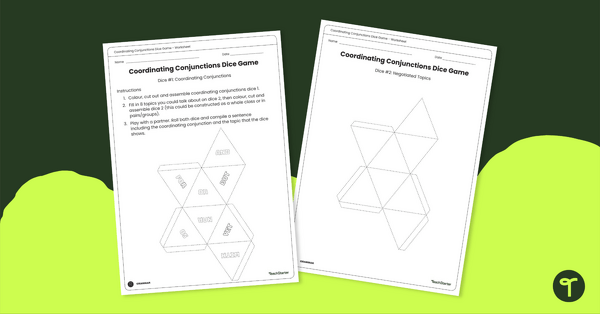
Coordinating Conjunctions Dice Game
Use this hands on activity for students to create two 8 sided-dice and write compound sentences using coordinating conjunctions.
- Plus Plan
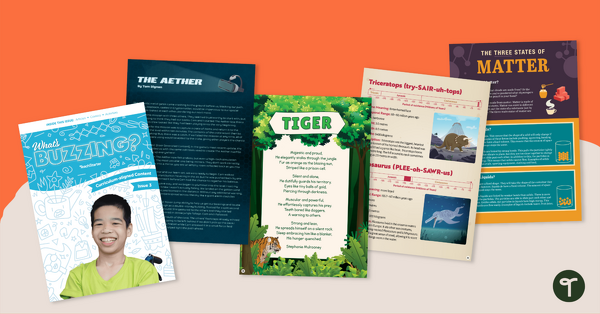
Year 5 Magazine – What's Buzzing? (Issue 3)
Issue 3 of our beautifully designed, 24-page reading magazine specifically designed for Year 5 students.
- Plus Plan
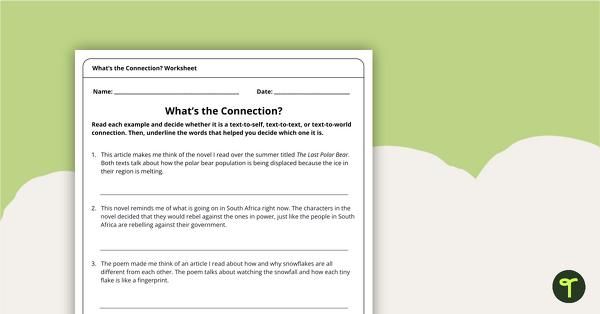
What's the Connection? Worksheet
Use this reading skills worksheet to help your students learn about the types of text connections: text-to-text, text-to-self and text-to-world.
- Free Plan

Finding the Main Idea in a Literary Text Worksheet
Find the main idea and supporting story clues of a literary text passage and answer the comprehension questions.
- Plus Plan

Snag-a-Suffix Claw Machine Interactive Review Game
Review knowledge of suffixes with an exciting interactive claw machine game!
- Plus Plan

Google Slides Interactive - Prefixes Activity
Practise adding prefixes to words by identifying, defining, and matching them in context.
- Plus Plan
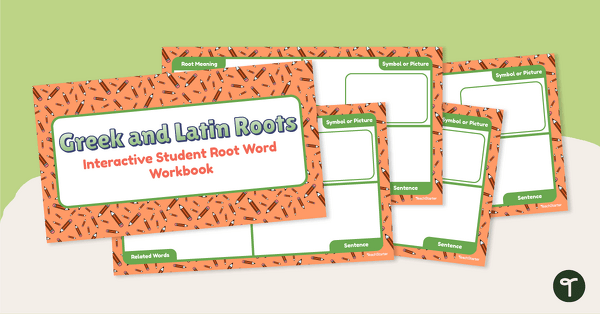
Greek and Latin Roots- Vocabulary Notebook
Enhance vocabulary containing Greek and Latin roots with a Google Slides Interactive vocabulary notebook. Also available in print format.
- Plus Plan
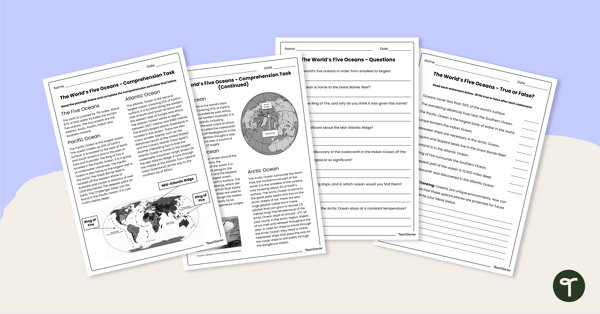
The World's Oceans - Comprehension Worksheet
Explore the world’s five oceans with this detailed comprehension passage and related questions.
- Plus Plan

Wheely Wonderful Words – Overused Verbs
Get rid of those overused verbs with a word wheel of synonyms.
- Plus Plan
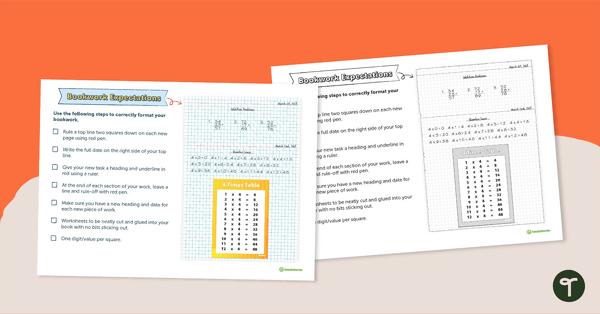
Numeracy Bookwork Expectations Posters
A checklist for students to refer to when displaying numeracy bookwork. There are low colour and black and white versions, plus editable versions in case you need to add your own expectations.
- Plus Plan
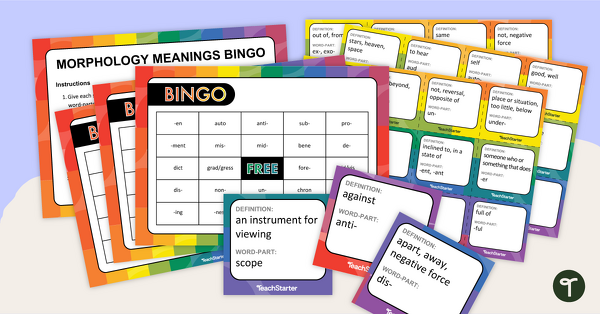
Morphology Meanings Bingo
Examine word parts and identify their morphological meanings in this BINGO game.
- Plus Plan
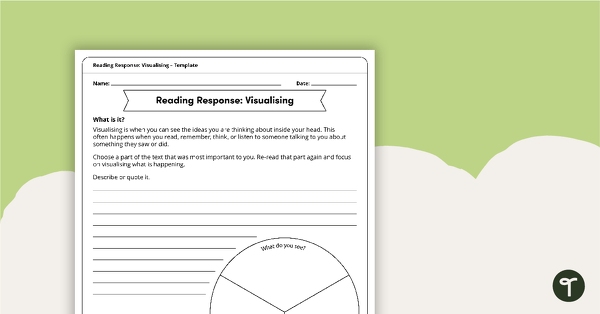
Reading Response Visualising – Template
A comprehension template for students to practise visualising.
- Plus Plan
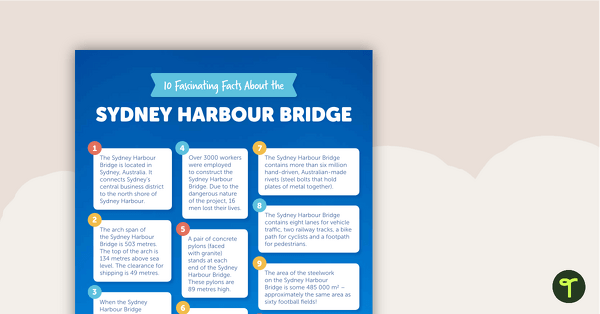
10 Fascinating Facts About the Sydney Harbour Bridge – Comprehension Worksheet
A comprehension worksheet for an article including ten facts about the Sydney Harbour Bridge in Australia.
- Plus Plan

Liquid Ice – Worksheet
A comprehension worksheet for a fake advertisement from the Year 5 magazine (Issue 3).
- Free Plan
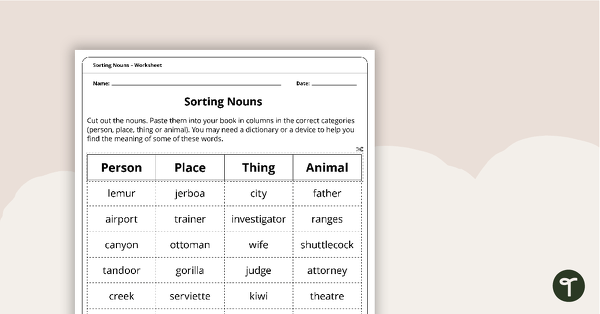
Sorting Nouns - Worksheet
A cut and arrange activity which involves students using their grammar skill to sort through nouns and categorise them.
- Plus Plan
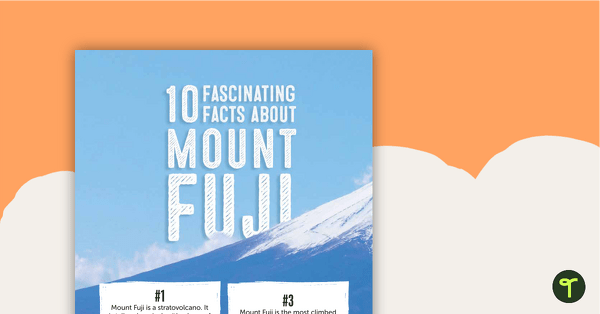
10 Fascinating Facts About Mount Fuji – Worksheet
A comprehension worksheet for an article from the Year 6 magazine (Issue 3).
- Plus Plan
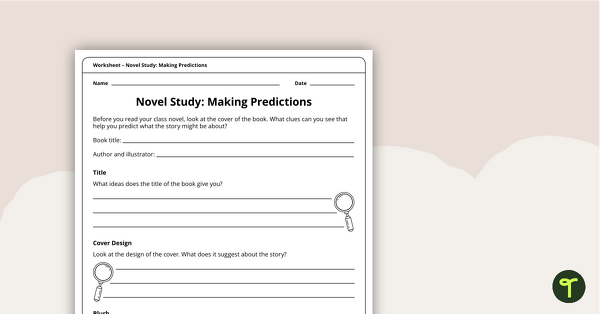
Novel Study – Making Predictions Worksheet
Make predictions before reading a novel with this novel study worksheet.
- Plus Plan
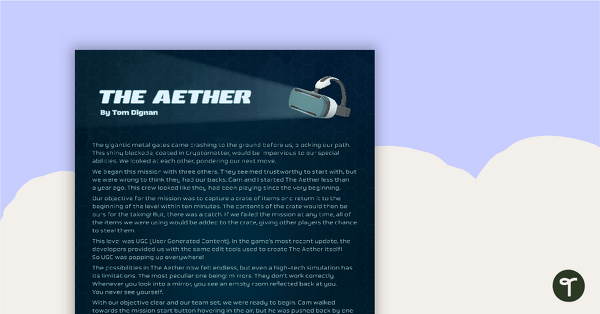
The Aether – Worksheet
A comprehension worksheet for a narrative from the Year 5 magazine (Issue 3).
- Plus Plan
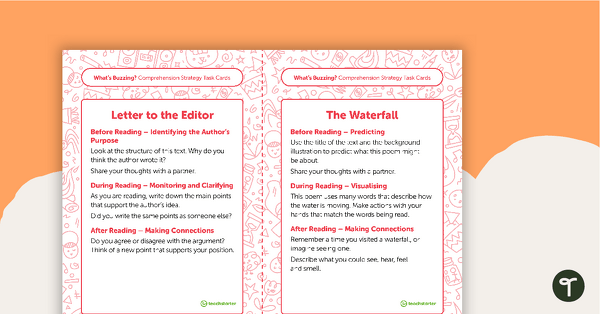
Year 2 Magazine - "What's Buzzing?" (Issue 2) Task Cards
A set of five literacy rotation task cards to be used in conjunction with Issue 2 of Teach Starter’s Year 2 magazine.
- Plus Plan
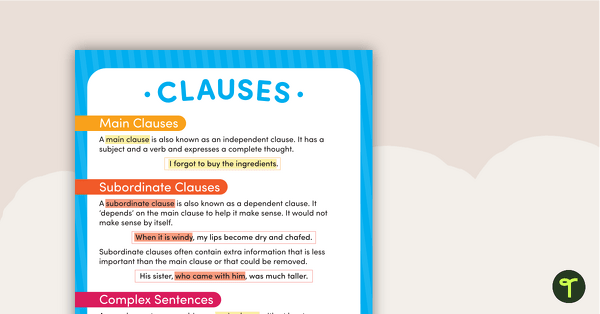
Main Clauses and Subordinate Clauses Poster
A poster explaining main clauses and subordinate clauses.
- Plus Plan
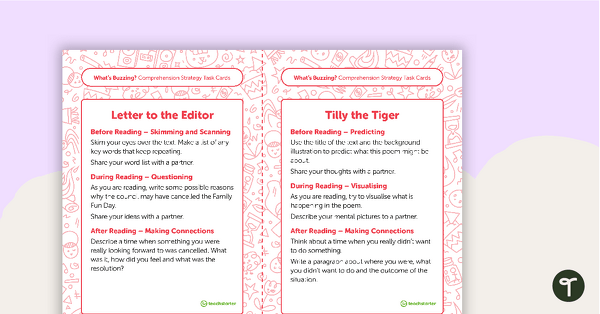
Year 3 Magazine - "What's Buzzing?" (Issue 2) Task Cards
A set of five literacy rotation task cards to be used in conjunction with Issue 2 of Teach Starter’s Year 3 magazine.
- Plus Plan
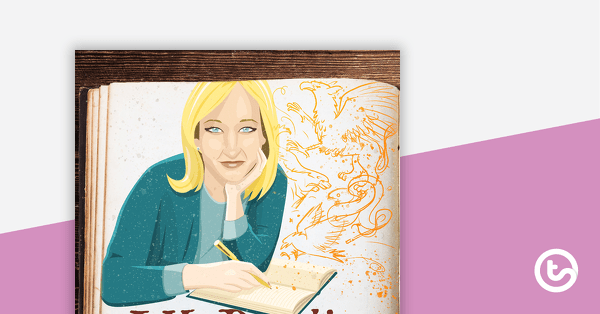
J. K. Rowling Biography – Worksheet
A comprehension worksheet for a biography from the Year 5 magazine (Issue 2).
- Plus Plan

NightyNite Napping Pod – Worksheet
A comprehension worksheet for a fake advertisement from the Year 6 magazine (Issue 3).
- Plus Plan
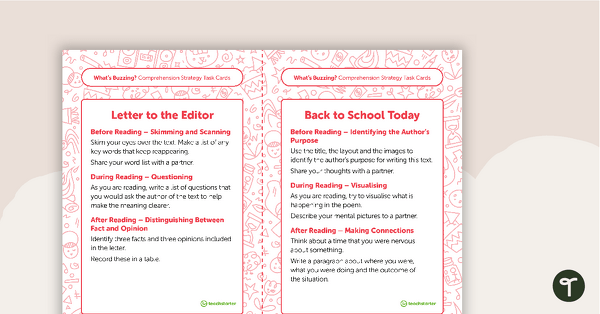
Year 4 Magazine - "What's Buzzing?" (Issue 2) Task Cards
A set of five literacy rotation task cards to be used in conjunction with Issue 2 of Teach Starter’s Year 4 magazine.
- Plus Plan
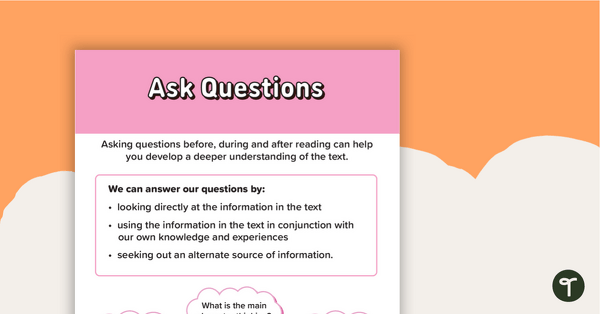
Ask Questions Poster
A poster highlighting how to ask questions when reading a piece of text.
- Plus Plan
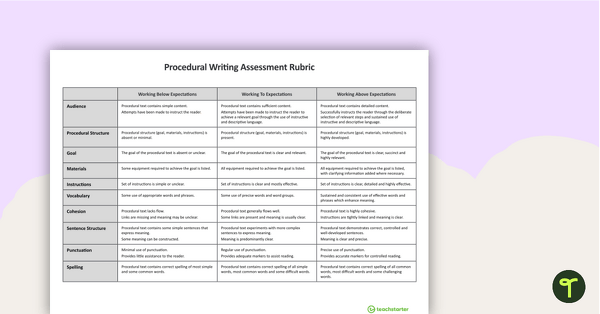
NAPLAN-Style Assessment Rubric - Procedural Writing
A NAPLAN-style rubric designed to help teachers to assess students' procedural writing.
- Plus Plan
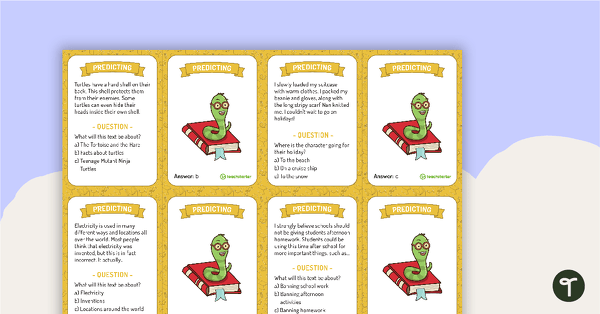
Out of the Book - Comprehension Board Game
A fun comprehension strategy board game for students to play during literacy rotations.
- Free Plan
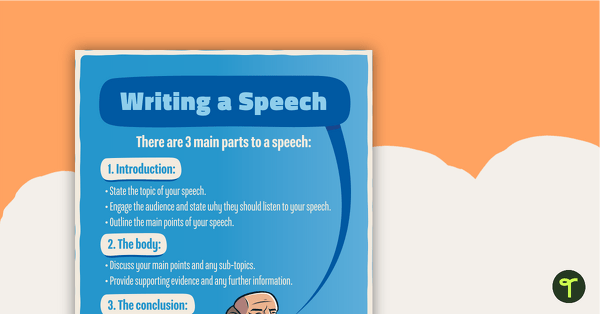
Writing a Speech Poster
A poster highlighting the main parts to a speech.
- Plus Plan
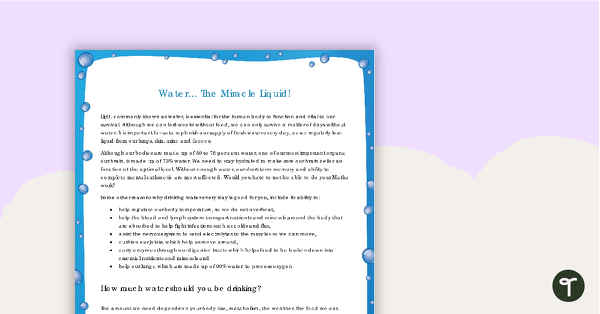
Comprehension – Why Our Bodies Need Water
A comprehension activity about 'Why Our Bodies Need Water'.
- Plus Plan
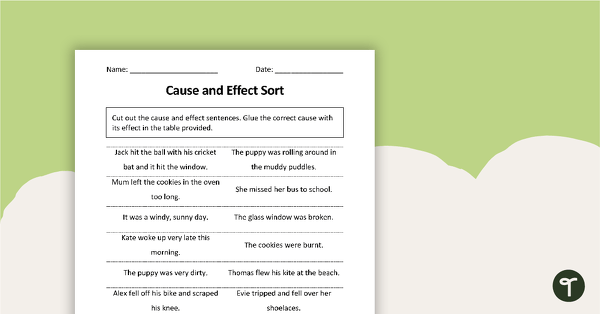
Cause and Effect - Sentence Sort Worksheet
A worksheet and answer sheet to use when teaching students the cause and effect comprehension strategy.
- Plus Plan
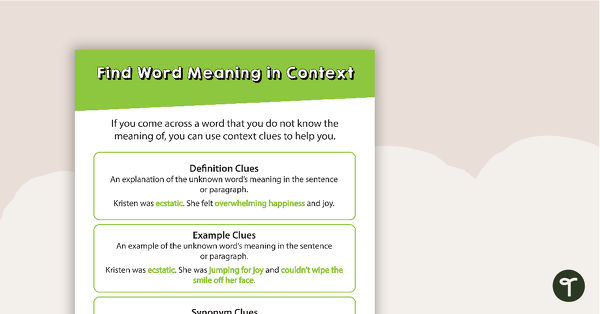
Comprehension Task Cards - Finding Word Meaning In Context
A set of comprehension task cards to help students find word meaning in context when reading.
- Plus Plan

Comprehension - Muddy Footprint Mystery
A fun script and set of questions to help students develop reading and comprehension strategies.